Algonquin College MGT1103 Case Study: Unlimited Combines Analysis
VerifiedAdded on 2022/02/04
|16
|3741
|44
Case Study
AI Summary
This case study analyzes the market entry strategies for Unlimited Combines, a Canadian farm equipment manufacturer, focusing on their frustrating experience in the Japanese market and the importance of a well-defined international market entry strategy. The analysis includes a SWOT analysis to identify strengths, weaknesses, opportunities, and threats, highlighting the company's technological advantage and lack of international experience. The core problem identified is the failure to create and implement an effective market entry strategy due to poor market research. The case study proposes evaluative criteria based on economic factors, intellectual property protection, and expansion opportunities to assess potential international markets. Alternatives such as focusing on the United States, China, and India are discussed, along with the benefits of direct versus indirect exporting strategies. The decision and justification favor the United States due to its proximity, free trade agreement, and the suitability of the company's technology for grain farming. The case study concludes with recommendations for implementation, emphasizing the importance of thorough market research, understanding cultural differences, and utilizing appropriate entry strategies for successful international expansion. The case study also answers questions regarding the company's international business, including its evaluative criteria, analysis of alternatives, and recommendations for implementation.
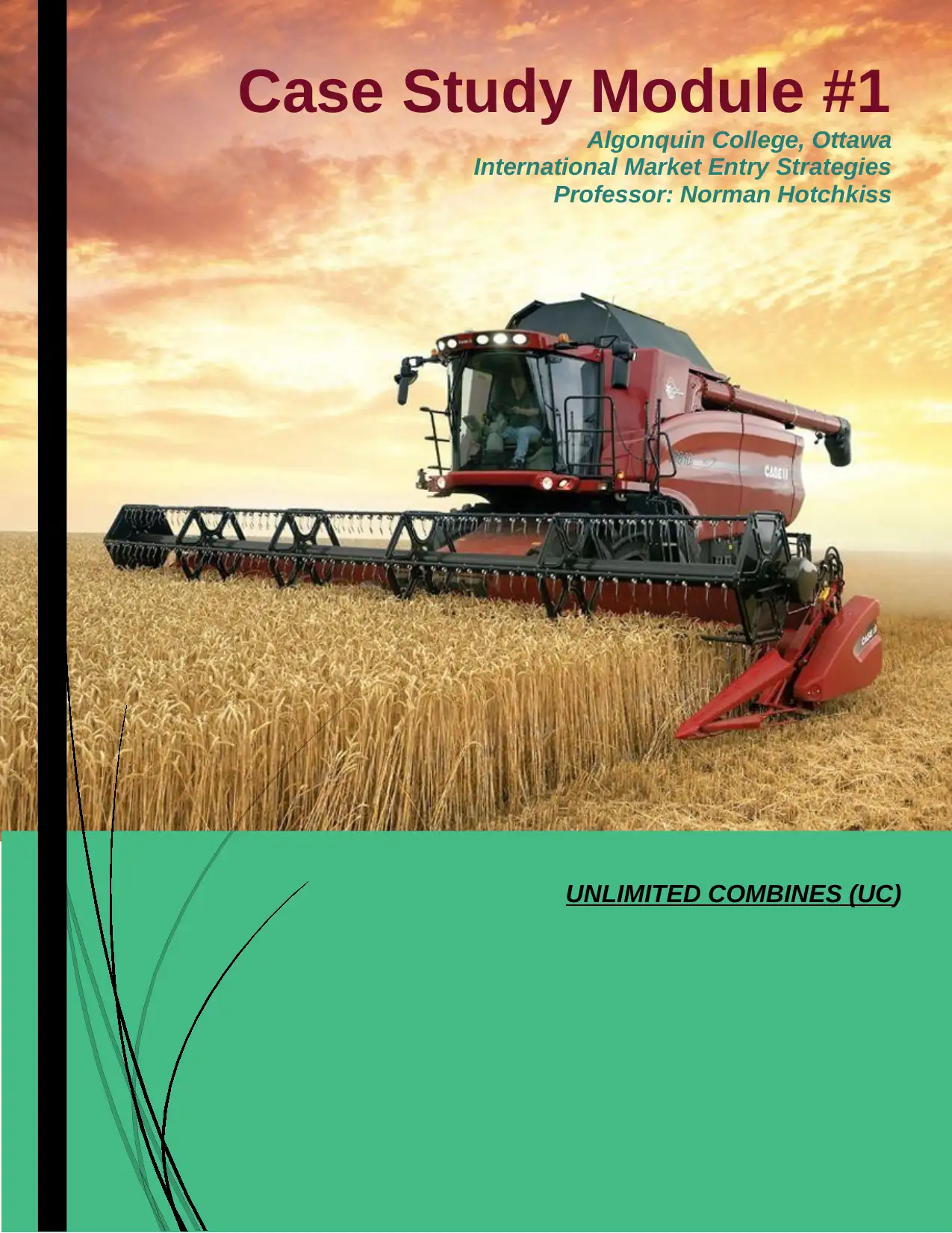
Case Study Module #1
Algonquin College, Ottawa
International Market Entry Strategies
Professor: Norman Hotchkiss
UNLIMITED COMBINES (UC)
Algonquin College, Ottawa
International Market Entry Strategies
Professor: Norman Hotchkiss
UNLIMITED COMBINES (UC)
Paraphrase This Document
Need a fresh take? Get an instant paraphrase of this document with our AI Paraphraser
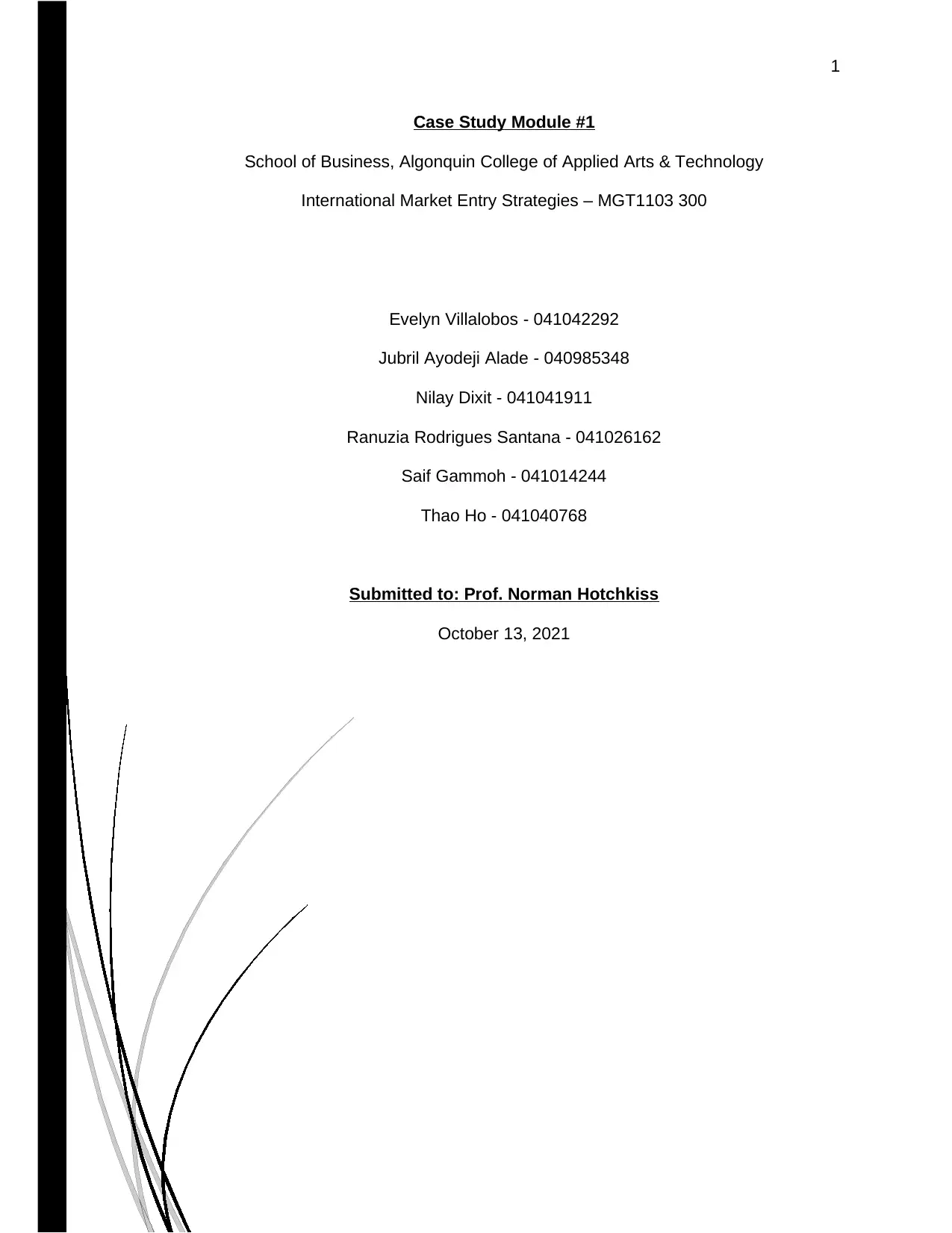
1
Case Study Module #1
School of Business, Algonquin College of Applied Arts & Technology
International Market Entry Strategies – MGT1103 300
Evelyn Villalobos - 041042292
Jubril Ayodeji Alade - 040985348
Nilay Dixit - 041041911
Ranuzia Rodrigues Santana - 041026162
Saif Gammoh - 041014244
Thao Ho - 041040768
Submitted to: Prof. Norman Hotchkiss
October 13, 2021
Case Study Module #1
School of Business, Algonquin College of Applied Arts & Technology
International Market Entry Strategies – MGT1103 300
Evelyn Villalobos - 041042292
Jubril Ayodeji Alade - 040985348
Nilay Dixit - 041041911
Ranuzia Rodrigues Santana - 041026162
Saif Gammoh - 041014244
Thao Ho - 041040768
Submitted to: Prof. Norman Hotchkiss
October 13, 2021
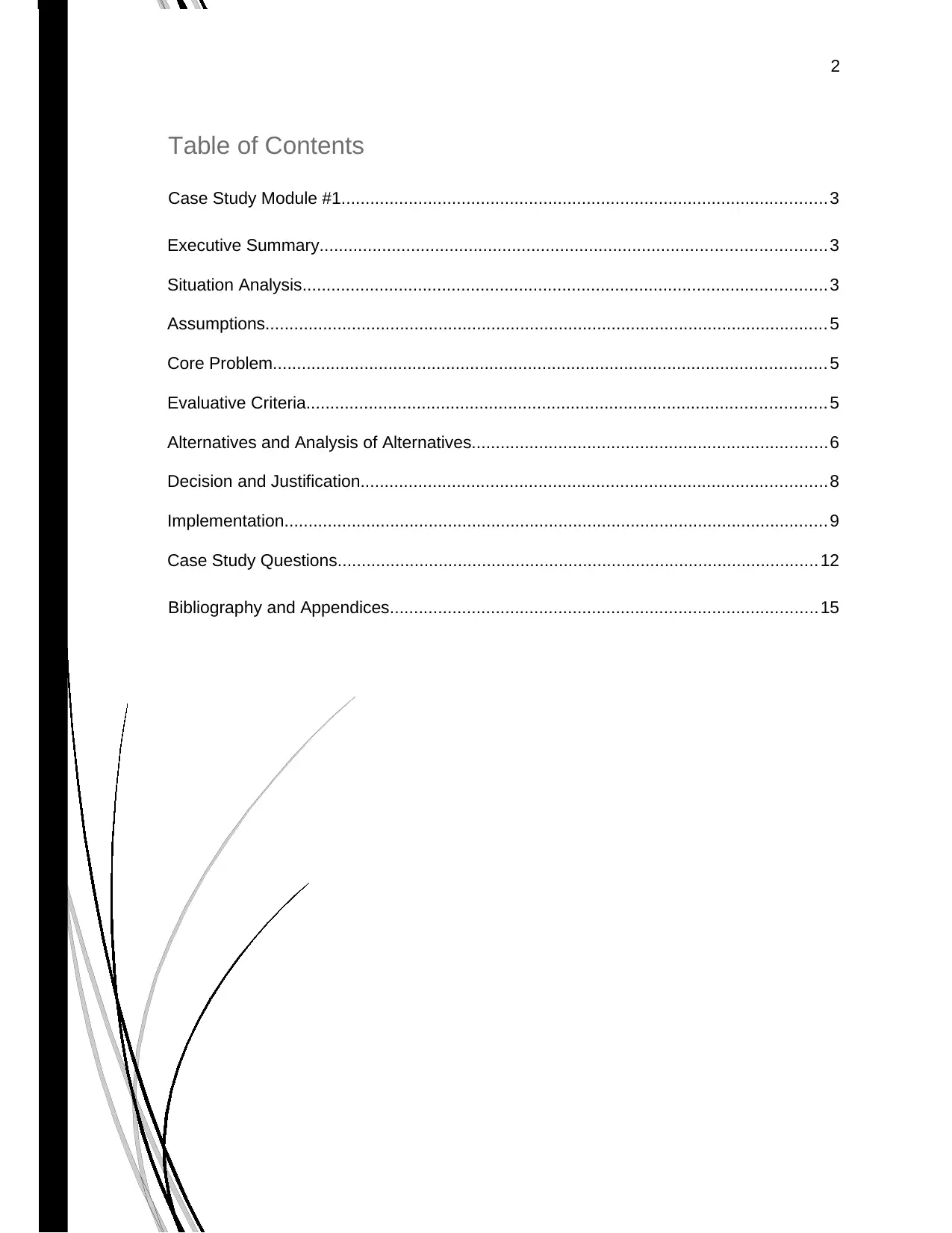
2
Table of Contents
Case Study Module #1.....................................................................................................3
Executive Summary.........................................................................................................3
Situation Analysis.............................................................................................................3
Assumptions..................................................................................................................... 5
Core Problem................................................................................................................... 5
Evaluative Criteria............................................................................................................ 5
Alternatives and Analysis of Alternatives..........................................................................6
Decision and Justification.................................................................................................8
Implementation.................................................................................................................9
Case Study Questions....................................................................................................12
Bibliography and Appendices.........................................................................................15
Table of Contents
Case Study Module #1.....................................................................................................3
Executive Summary.........................................................................................................3
Situation Analysis.............................................................................................................3
Assumptions..................................................................................................................... 5
Core Problem................................................................................................................... 5
Evaluative Criteria............................................................................................................ 5
Alternatives and Analysis of Alternatives..........................................................................6
Decision and Justification.................................................................................................8
Implementation.................................................................................................................9
Case Study Questions....................................................................................................12
Bibliography and Appendices.........................................................................................15
⊘ This is a preview!⊘
Do you want full access?
Subscribe today to unlock all pages.

Trusted by 1+ million students worldwide
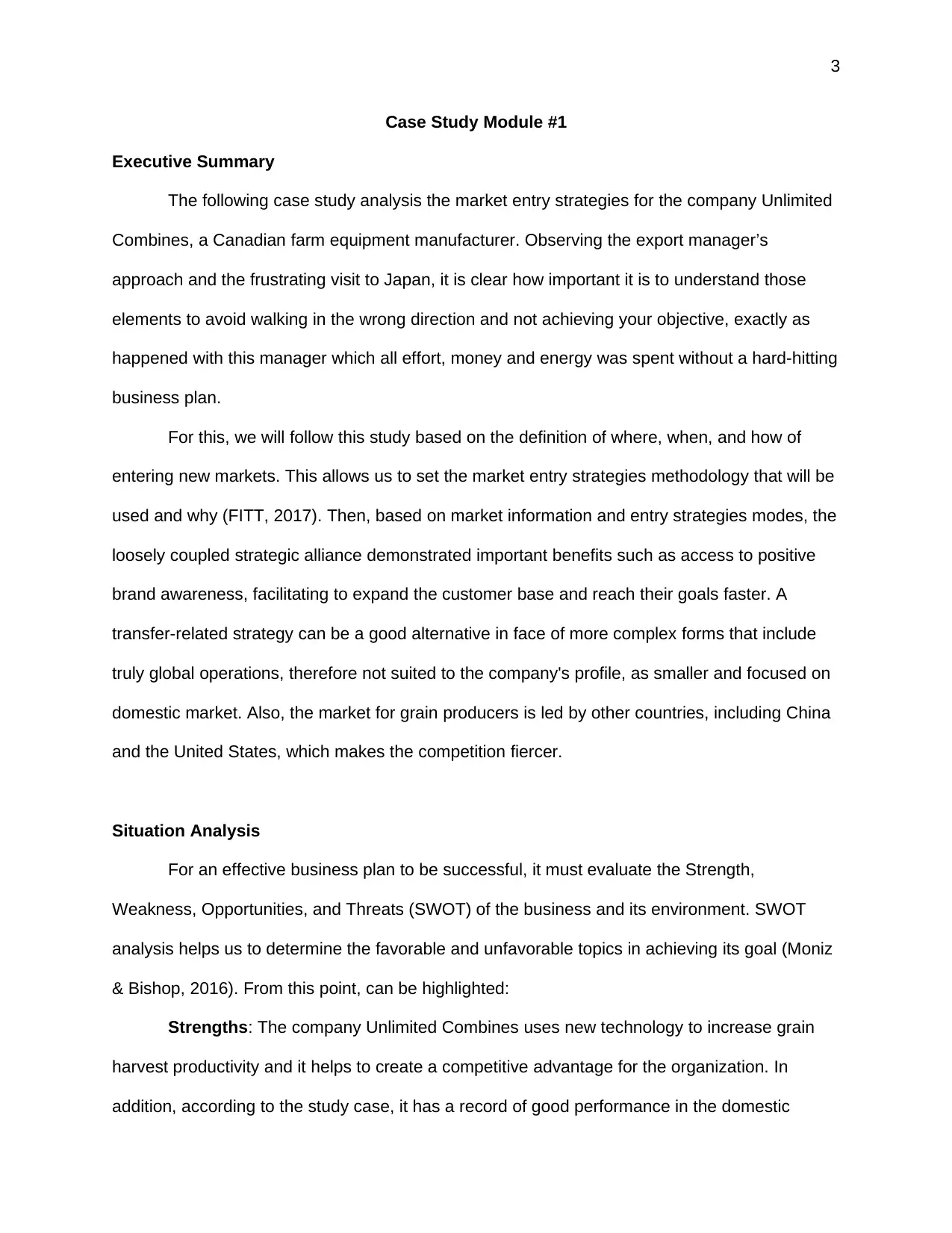
3
Case Study Module #1
Executive Summary
The following case study analysis the market entry strategies for the company Unlimited
Combines, a Canadian farm equipment manufacturer. Observing the export manager’s
approach and the frustrating visit to Japan, it is clear how important it is to understand those
elements to avoid walking in the wrong direction and not achieving your objective, exactly as
happened with this manager which all effort, money and energy was spent without a hard-hitting
business plan.
For this, we will follow this study based on the definition of where, when, and how of
entering new markets. This allows us to set the market entry strategies methodology that will be
used and why (FITT, 2017). Then, based on market information and entry strategies modes, the
loosely coupled strategic alliance demonstrated important benefits such as access to positive
brand awareness, facilitating to expand the customer base and reach their goals faster. A
transfer-related strategy can be a good alternative in face of more complex forms that include
truly global operations, therefore not suited to the company's profile, as smaller and focused on
domestic market. Also, the market for grain producers is led by other countries, including China
and the United States, which makes the competition fiercer.
Situation Analysis
For an effective business plan to be successful, it must evaluate the Strength,
Weakness, Opportunities, and Threats (SWOT) of the business and its environment. SWOT
analysis helps us to determine the favorable and unfavorable topics in achieving its goal (Moniz
& Bishop, 2016). From this point, can be highlighted:
Strengths: The company Unlimited Combines uses new technology to increase grain
harvest productivity and it helps to create a competitive advantage for the organization. In
addition, according to the study case, it has a record of good performance in the domestic
Case Study Module #1
Executive Summary
The following case study analysis the market entry strategies for the company Unlimited
Combines, a Canadian farm equipment manufacturer. Observing the export manager’s
approach and the frustrating visit to Japan, it is clear how important it is to understand those
elements to avoid walking in the wrong direction and not achieving your objective, exactly as
happened with this manager which all effort, money and energy was spent without a hard-hitting
business plan.
For this, we will follow this study based on the definition of where, when, and how of
entering new markets. This allows us to set the market entry strategies methodology that will be
used and why (FITT, 2017). Then, based on market information and entry strategies modes, the
loosely coupled strategic alliance demonstrated important benefits such as access to positive
brand awareness, facilitating to expand the customer base and reach their goals faster. A
transfer-related strategy can be a good alternative in face of more complex forms that include
truly global operations, therefore not suited to the company's profile, as smaller and focused on
domestic market. Also, the market for grain producers is led by other countries, including China
and the United States, which makes the competition fiercer.
Situation Analysis
For an effective business plan to be successful, it must evaluate the Strength,
Weakness, Opportunities, and Threats (SWOT) of the business and its environment. SWOT
analysis helps us to determine the favorable and unfavorable topics in achieving its goal (Moniz
& Bishop, 2016). From this point, can be highlighted:
Strengths: The company Unlimited Combines uses new technology to increase grain
harvest productivity and it helps to create a competitive advantage for the organization. In
addition, according to the study case, it has a record of good performance in the domestic
Paraphrase This Document
Need a fresh take? Get an instant paraphrase of this document with our AI Paraphraser
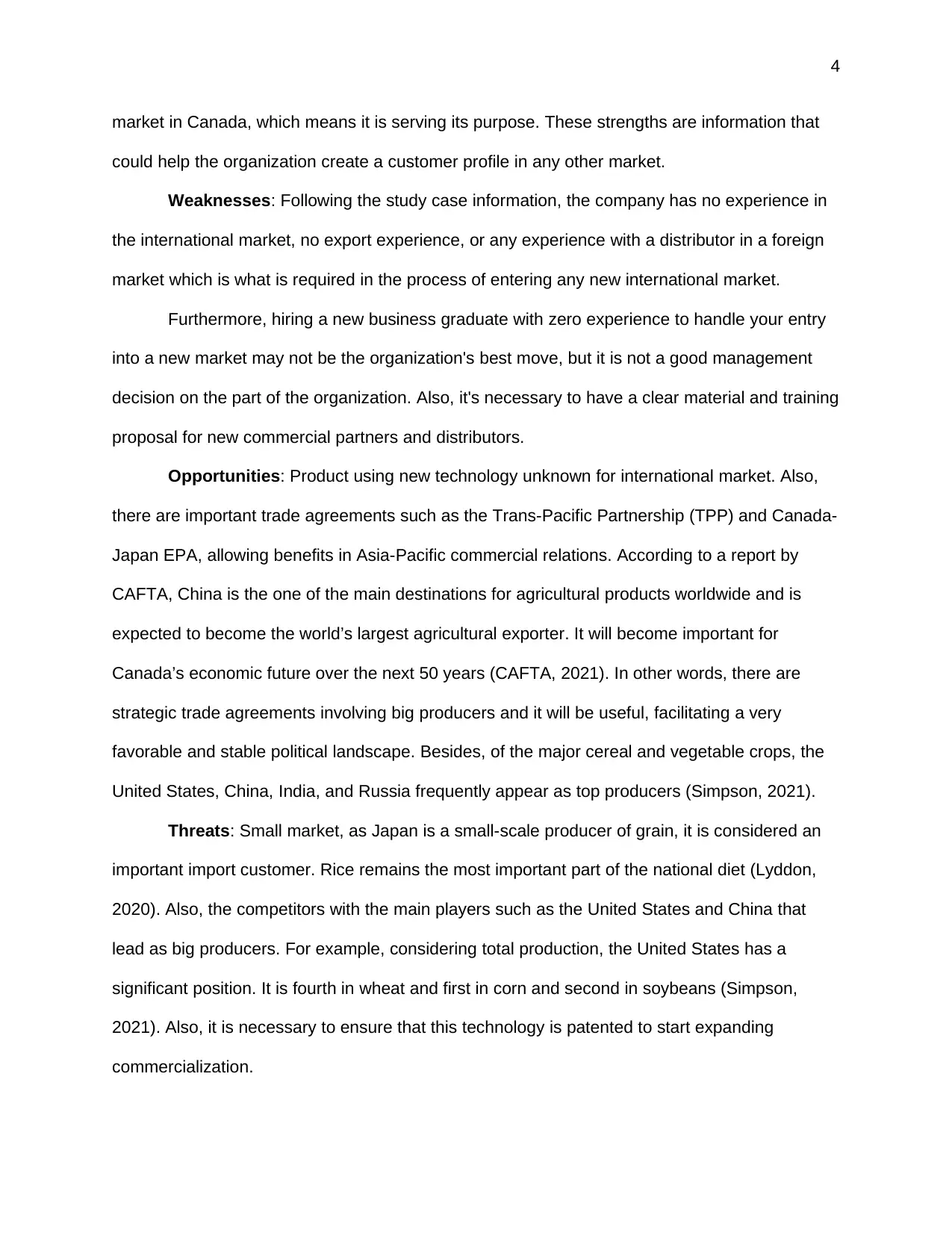
4
market in Canada, which means it is serving its purpose. These strengths are information that
could help the organization create a customer profile in any other market.
Weaknesses: Following the study case information, the company has no experience in
the international market, no export experience, or any experience with a distributor in a foreign
market which is what is required in the process of entering any new international market.
Furthermore, hiring a new business graduate with zero experience to handle your entry
into a new market may not be the organization's best move, but it is not a good management
decision on the part of the organization. Also, it's necessary to have a clear material and training
proposal for new commercial partners and distributors.
Opportunities: Product using new technology unknown for international market. Also,
there are important trade agreements such as the Trans-Pacific Partnership (TPP) and Canada-
Japan EPA, allowing benefits in Asia-Pacific commercial relations. According to a report by
CAFTA, China is the one of the main destinations for agricultural products worldwide and is
expected to become the world’s largest agricultural exporter. It will become important for
Canada’s economic future over the next 50 years (CAFTA, 2021). In other words, there are
strategic trade agreements involving big producers and it will be useful, facilitating a very
favorable and stable political landscape. Besides, of the major cereal and vegetable crops, the
United States, China, India, and Russia frequently appear as top producers (Simpson, 2021).
Threats: Small market, as Japan is a small-scale producer of grain, it is considered an
important import customer. Rice remains the most important part of the national diet (Lyddon,
2020). Also, the competitors with the main players such as the United States and China that
lead as big producers. For example, considering total production, the United States has a
significant position. It is fourth in wheat and first in corn and second in soybeans (Simpson,
2021). Also, it is necessary to ensure that this technology is patented to start expanding
commercialization.
market in Canada, which means it is serving its purpose. These strengths are information that
could help the organization create a customer profile in any other market.
Weaknesses: Following the study case information, the company has no experience in
the international market, no export experience, or any experience with a distributor in a foreign
market which is what is required in the process of entering any new international market.
Furthermore, hiring a new business graduate with zero experience to handle your entry
into a new market may not be the organization's best move, but it is not a good management
decision on the part of the organization. Also, it's necessary to have a clear material and training
proposal for new commercial partners and distributors.
Opportunities: Product using new technology unknown for international market. Also,
there are important trade agreements such as the Trans-Pacific Partnership (TPP) and Canada-
Japan EPA, allowing benefits in Asia-Pacific commercial relations. According to a report by
CAFTA, China is the one of the main destinations for agricultural products worldwide and is
expected to become the world’s largest agricultural exporter. It will become important for
Canada’s economic future over the next 50 years (CAFTA, 2021). In other words, there are
strategic trade agreements involving big producers and it will be useful, facilitating a very
favorable and stable political landscape. Besides, of the major cereal and vegetable crops, the
United States, China, India, and Russia frequently appear as top producers (Simpson, 2021).
Threats: Small market, as Japan is a small-scale producer of grain, it is considered an
important import customer. Rice remains the most important part of the national diet (Lyddon,
2020). Also, the competitors with the main players such as the United States and China that
lead as big producers. For example, considering total production, the United States has a
significant position. It is fourth in wheat and first in corn and second in soybeans (Simpson,
2021). Also, it is necessary to ensure that this technology is patented to start expanding
commercialization.
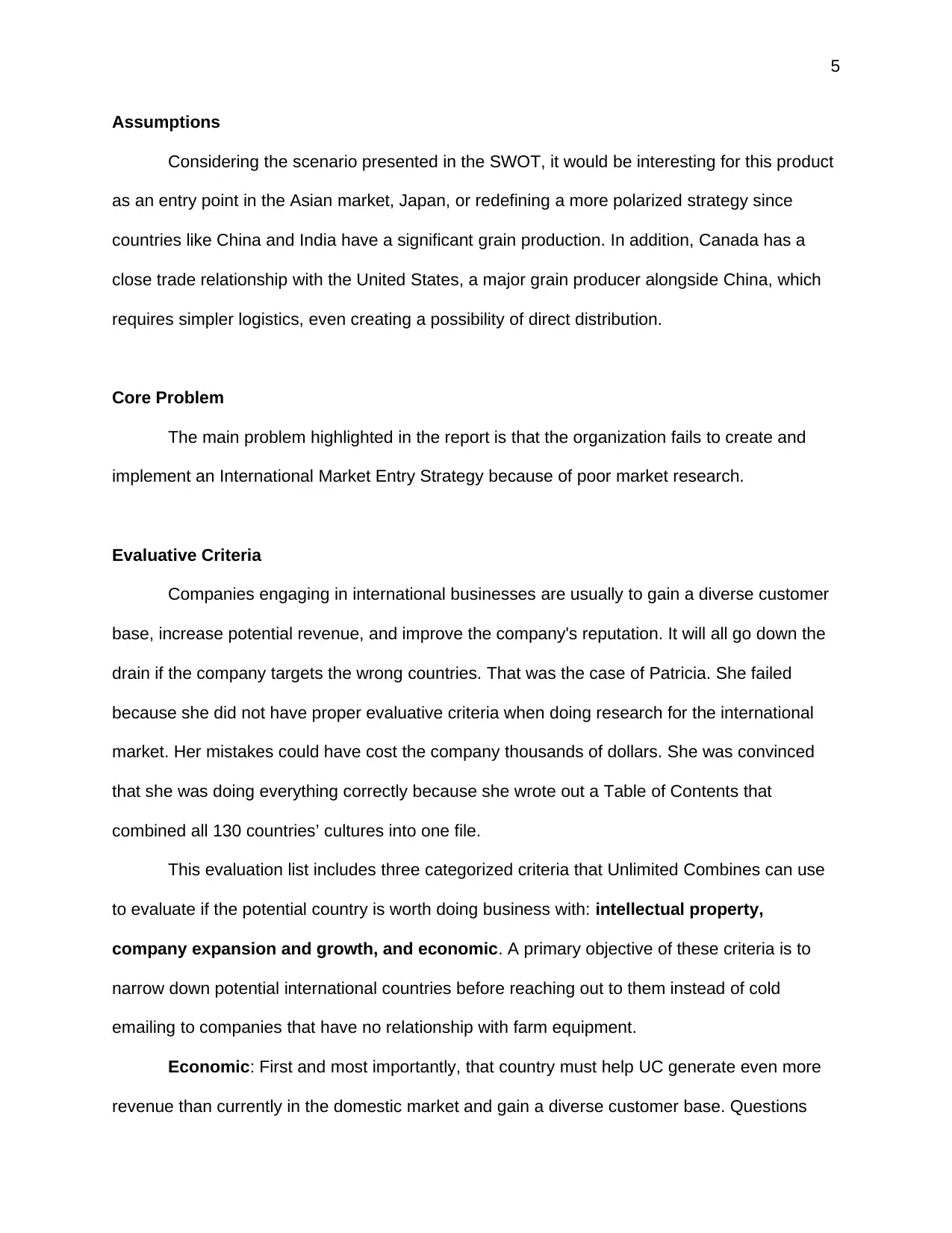
5
Assumptions
Considering the scenario presented in the SWOT, it would be interesting for this product
as an entry point in the Asian market, Japan, or redefining a more polarized strategy since
countries like China and India have a significant grain production. In addition, Canada has a
close trade relationship with the United States, a major grain producer alongside China, which
requires simpler logistics, even creating a possibility of direct distribution.
Core Problem
The main problem highlighted in the report is that the organization fails to create and
implement an International Market Entry Strategy because of poor market research.
Evaluative Criteria
Companies engaging in international businesses are usually to gain a diverse customer
base, increase potential revenue, and improve the company's reputation. It will all go down the
drain if the company targets the wrong countries. That was the case of Patricia. She failed
because she did not have proper evaluative criteria when doing research for the international
market. Her mistakes could have cost the company thousands of dollars. She was convinced
that she was doing everything correctly because she wrote out a Table of Contents that
combined all 130 countries’ cultures into one file.
This evaluation list includes three categorized criteria that Unlimited Combines can use
to evaluate if the potential country is worth doing business with: intellectual property,
company expansion and growth, and economic. A primary objective of these criteria is to
narrow down potential international countries before reaching out to them instead of cold
emailing to companies that have no relationship with farm equipment.
Economic: First and most importantly, that country must help UC generate even more
revenue than currently in the domestic market and gain a diverse customer base. Questions
Assumptions
Considering the scenario presented in the SWOT, it would be interesting for this product
as an entry point in the Asian market, Japan, or redefining a more polarized strategy since
countries like China and India have a significant grain production. In addition, Canada has a
close trade relationship with the United States, a major grain producer alongside China, which
requires simpler logistics, even creating a possibility of direct distribution.
Core Problem
The main problem highlighted in the report is that the organization fails to create and
implement an International Market Entry Strategy because of poor market research.
Evaluative Criteria
Companies engaging in international businesses are usually to gain a diverse customer
base, increase potential revenue, and improve the company's reputation. It will all go down the
drain if the company targets the wrong countries. That was the case of Patricia. She failed
because she did not have proper evaluative criteria when doing research for the international
market. Her mistakes could have cost the company thousands of dollars. She was convinced
that she was doing everything correctly because she wrote out a Table of Contents that
combined all 130 countries’ cultures into one file.
This evaluation list includes three categorized criteria that Unlimited Combines can use
to evaluate if the potential country is worth doing business with: intellectual property,
company expansion and growth, and economic. A primary objective of these criteria is to
narrow down potential international countries before reaching out to them instead of cold
emailing to companies that have no relationship with farm equipment.
Economic: First and most importantly, that country must help UC generate even more
revenue than currently in the domestic market and gain a diverse customer base. Questions
⊘ This is a preview!⊘
Do you want full access?
Subscribe today to unlock all pages.

Trusted by 1+ million students worldwide
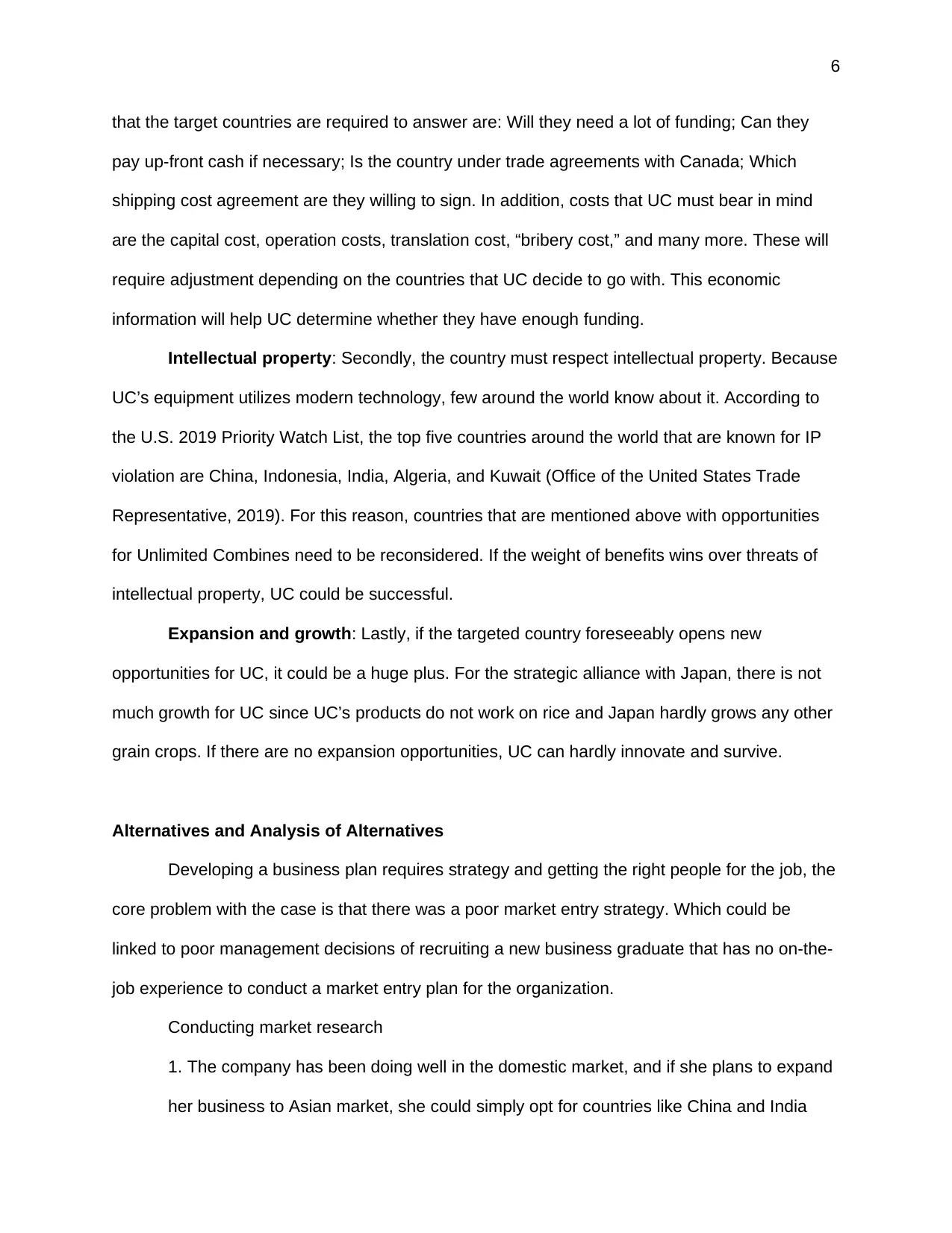
6
that the target countries are required to answer are: Will they need a lot of funding; Can they
pay up-front cash if necessary; Is the country under trade agreements with Canada; Which
shipping cost agreement are they willing to sign. In addition, costs that UC must bear in mind
are the capital cost, operation costs, translation cost, “bribery cost,” and many more. These will
require adjustment depending on the countries that UC decide to go with. This economic
information will help UC determine whether they have enough funding.
Intellectual property: Secondly, the country must respect intellectual property. Because
UC’s equipment utilizes modern technology, few around the world know about it. According to
the U.S. 2019 Priority Watch List, the top five countries around the world that are known for IP
violation are China, Indonesia, India, Algeria, and Kuwait (Office of the United States Trade
Representative, 2019). For this reason, countries that are mentioned above with opportunities
for Unlimited Combines need to be reconsidered. If the weight of benefits wins over threats of
intellectual property, UC could be successful.
Expansion and growth: Lastly, if the targeted country foreseeably opens new
opportunities for UC, it could be a huge plus. For the strategic alliance with Japan, there is not
much growth for UC since UC’s products do not work on rice and Japan hardly grows any other
grain crops. If there are no expansion opportunities, UC can hardly innovate and survive.
Alternatives and Analysis of Alternatives
Developing a business plan requires strategy and getting the right people for the job, the
core problem with the case is that there was a poor market entry strategy. Which could be
linked to poor management decisions of recruiting a new business graduate that has no on-the-
job experience to conduct a market entry plan for the organization.
Conducting market research
1. The company has been doing well in the domestic market, and if she plans to expand
her business to Asian market, she could simply opt for countries like China and India
that the target countries are required to answer are: Will they need a lot of funding; Can they
pay up-front cash if necessary; Is the country under trade agreements with Canada; Which
shipping cost agreement are they willing to sign. In addition, costs that UC must bear in mind
are the capital cost, operation costs, translation cost, “bribery cost,” and many more. These will
require adjustment depending on the countries that UC decide to go with. This economic
information will help UC determine whether they have enough funding.
Intellectual property: Secondly, the country must respect intellectual property. Because
UC’s equipment utilizes modern technology, few around the world know about it. According to
the U.S. 2019 Priority Watch List, the top five countries around the world that are known for IP
violation are China, Indonesia, India, Algeria, and Kuwait (Office of the United States Trade
Representative, 2019). For this reason, countries that are mentioned above with opportunities
for Unlimited Combines need to be reconsidered. If the weight of benefits wins over threats of
intellectual property, UC could be successful.
Expansion and growth: Lastly, if the targeted country foreseeably opens new
opportunities for UC, it could be a huge plus. For the strategic alliance with Japan, there is not
much growth for UC since UC’s products do not work on rice and Japan hardly grows any other
grain crops. If there are no expansion opportunities, UC can hardly innovate and survive.
Alternatives and Analysis of Alternatives
Developing a business plan requires strategy and getting the right people for the job, the
core problem with the case is that there was a poor market entry strategy. Which could be
linked to poor management decisions of recruiting a new business graduate that has no on-the-
job experience to conduct a market entry plan for the organization.
Conducting market research
1. The company has been doing well in the domestic market, and if she plans to expand
her business to Asian market, she could simply opt for countries like China and India
Paraphrase This Document
Need a fresh take? Get an instant paraphrase of this document with our AI Paraphraser
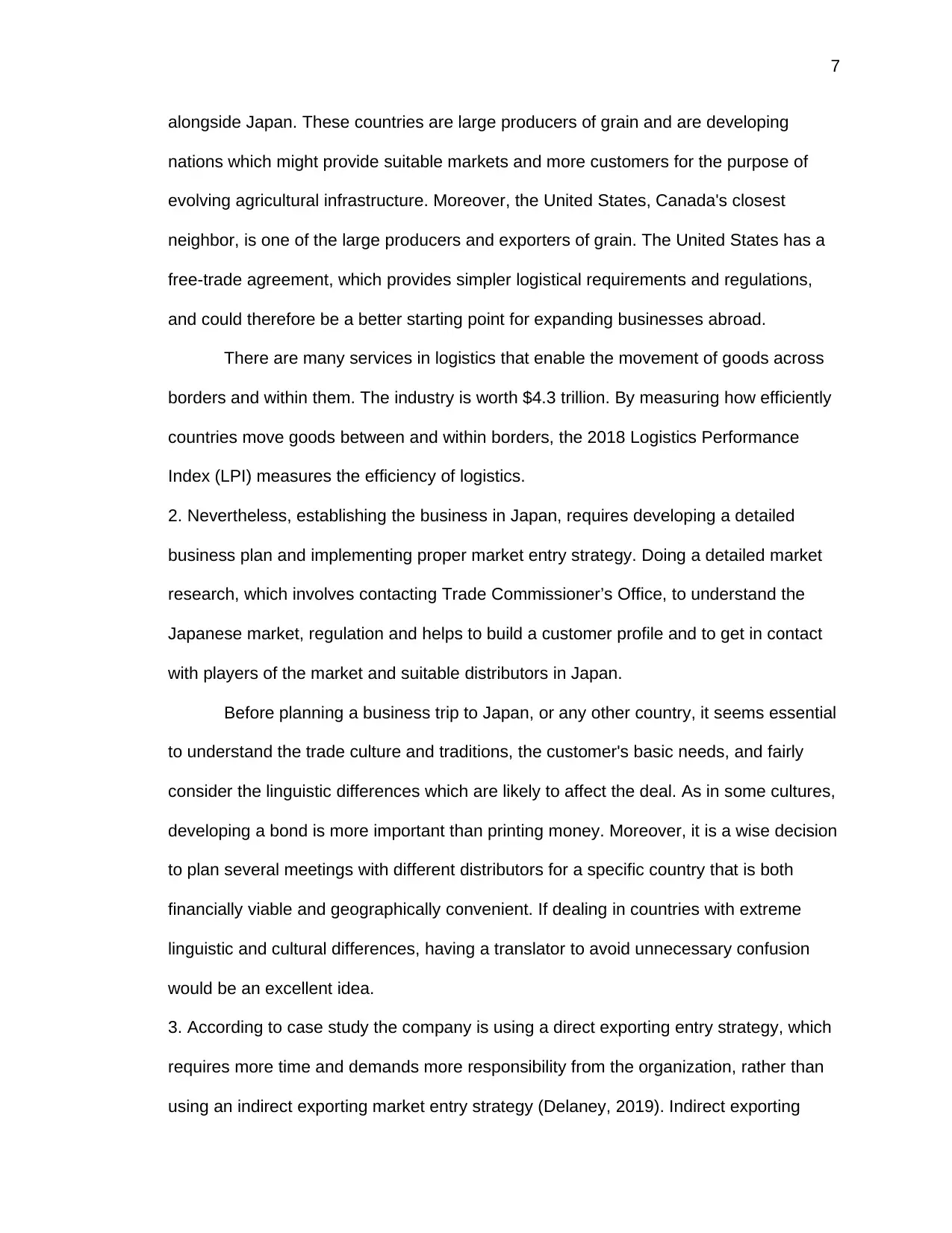
7
alongside Japan. These countries are large producers of grain and are developing
nations which might provide suitable markets and more customers for the purpose of
evolving agricultural infrastructure. Moreover, the United States, Canada's closest
neighbor, is one of the large producers and exporters of grain. The United States has a
free-trade agreement, which provides simpler logistical requirements and regulations,
and could therefore be a better starting point for expanding businesses abroad.
There are many services in logistics that enable the movement of goods across
borders and within them. The industry is worth $4.3 trillion. By measuring how efficiently
countries move goods between and within borders, the 2018 Logistics Performance
Index (LPI) measures the efficiency of logistics.
2. Nevertheless, establishing the business in Japan, requires developing a detailed
business plan and implementing proper market entry strategy. Doing a detailed market
research, which involves contacting Trade Commissioner’s Office, to understand the
Japanese market, regulation and helps to build a customer profile and to get in contact
with players of the market and suitable distributors in Japan.
Before planning a business trip to Japan, or any other country, it seems essential
to understand the trade culture and traditions, the customer's basic needs, and fairly
consider the linguistic differences which are likely to affect the deal. As in some cultures,
developing a bond is more important than printing money. Moreover, it is a wise decision
to plan several meetings with different distributors for a specific country that is both
financially viable and geographically convenient. If dealing in countries with extreme
linguistic and cultural differences, having a translator to avoid unnecessary confusion
would be an excellent idea.
3. According to case study the company is using a direct exporting entry strategy, which
requires more time and demands more responsibility from the organization, rather than
using an indirect exporting market entry strategy (Delaney, 2019). Indirect exporting
alongside Japan. These countries are large producers of grain and are developing
nations which might provide suitable markets and more customers for the purpose of
evolving agricultural infrastructure. Moreover, the United States, Canada's closest
neighbor, is one of the large producers and exporters of grain. The United States has a
free-trade agreement, which provides simpler logistical requirements and regulations,
and could therefore be a better starting point for expanding businesses abroad.
There are many services in logistics that enable the movement of goods across
borders and within them. The industry is worth $4.3 trillion. By measuring how efficiently
countries move goods between and within borders, the 2018 Logistics Performance
Index (LPI) measures the efficiency of logistics.
2. Nevertheless, establishing the business in Japan, requires developing a detailed
business plan and implementing proper market entry strategy. Doing a detailed market
research, which involves contacting Trade Commissioner’s Office, to understand the
Japanese market, regulation and helps to build a customer profile and to get in contact
with players of the market and suitable distributors in Japan.
Before planning a business trip to Japan, or any other country, it seems essential
to understand the trade culture and traditions, the customer's basic needs, and fairly
consider the linguistic differences which are likely to affect the deal. As in some cultures,
developing a bond is more important than printing money. Moreover, it is a wise decision
to plan several meetings with different distributors for a specific country that is both
financially viable and geographically convenient. If dealing in countries with extreme
linguistic and cultural differences, having a translator to avoid unnecessary confusion
would be an excellent idea.
3. According to case study the company is using a direct exporting entry strategy, which
requires more time and demands more responsibility from the organization, rather than
using an indirect exporting market entry strategy (Delaney, 2019). Indirect exporting
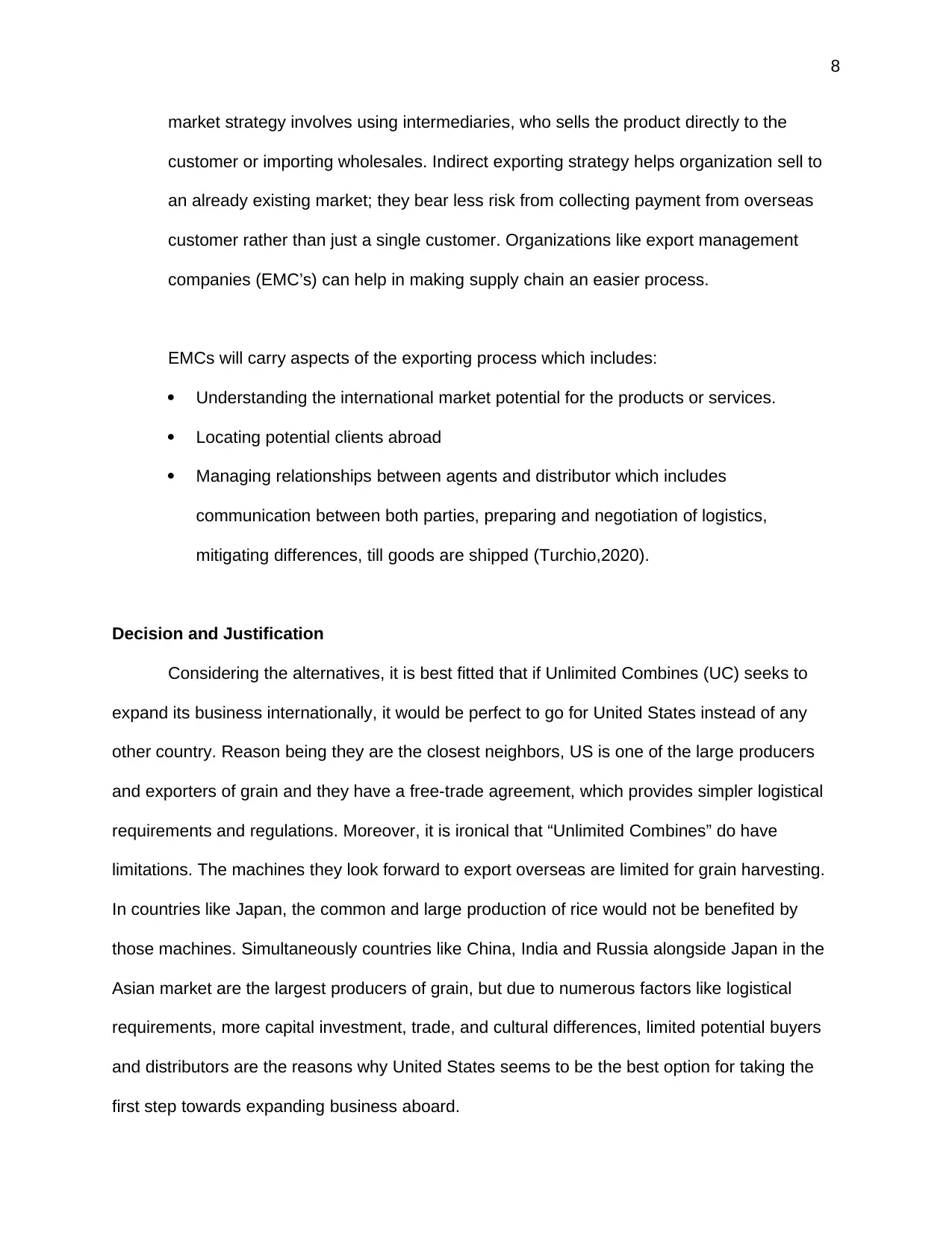
8
market strategy involves using intermediaries, who sells the product directly to the
customer or importing wholesales. Indirect exporting strategy helps organization sell to
an already existing market; they bear less risk from collecting payment from overseas
customer rather than just a single customer. Organizations like export management
companies (EMC’s) can help in making supply chain an easier process.
EMCs will carry aspects of the exporting process which includes:
Understanding the international market potential for the products or services.
Locating potential clients abroad
Managing relationships between agents and distributor which includes
communication between both parties, preparing and negotiation of logistics,
mitigating differences, till goods are shipped (Turchio,2020).
Decision and Justification
Considering the alternatives, it is best fitted that if Unlimited Combines (UC) seeks to
expand its business internationally, it would be perfect to go for United States instead of any
other country. Reason being they are the closest neighbors, US is one of the large producers
and exporters of grain and they have a free-trade agreement, which provides simpler logistical
requirements and regulations. Moreover, it is ironical that “Unlimited Combines” do have
limitations. The machines they look forward to export overseas are limited for grain harvesting.
In countries like Japan, the common and large production of rice would not be benefited by
those machines. Simultaneously countries like China, India and Russia alongside Japan in the
Asian market are the largest producers of grain, but due to numerous factors like logistical
requirements, more capital investment, trade, and cultural differences, limited potential buyers
and distributors are the reasons why United States seems to be the best option for taking the
first step towards expanding business aboard.
market strategy involves using intermediaries, who sells the product directly to the
customer or importing wholesales. Indirect exporting strategy helps organization sell to
an already existing market; they bear less risk from collecting payment from overseas
customer rather than just a single customer. Organizations like export management
companies (EMC’s) can help in making supply chain an easier process.
EMCs will carry aspects of the exporting process which includes:
Understanding the international market potential for the products or services.
Locating potential clients abroad
Managing relationships between agents and distributor which includes
communication between both parties, preparing and negotiation of logistics,
mitigating differences, till goods are shipped (Turchio,2020).
Decision and Justification
Considering the alternatives, it is best fitted that if Unlimited Combines (UC) seeks to
expand its business internationally, it would be perfect to go for United States instead of any
other country. Reason being they are the closest neighbors, US is one of the large producers
and exporters of grain and they have a free-trade agreement, which provides simpler logistical
requirements and regulations. Moreover, it is ironical that “Unlimited Combines” do have
limitations. The machines they look forward to export overseas are limited for grain harvesting.
In countries like Japan, the common and large production of rice would not be benefited by
those machines. Simultaneously countries like China, India and Russia alongside Japan in the
Asian market are the largest producers of grain, but due to numerous factors like logistical
requirements, more capital investment, trade, and cultural differences, limited potential buyers
and distributors are the reasons why United States seems to be the best option for taking the
first step towards expanding business aboard.
⊘ This is a preview!⊘
Do you want full access?
Subscribe today to unlock all pages.

Trusted by 1+ million students worldwide
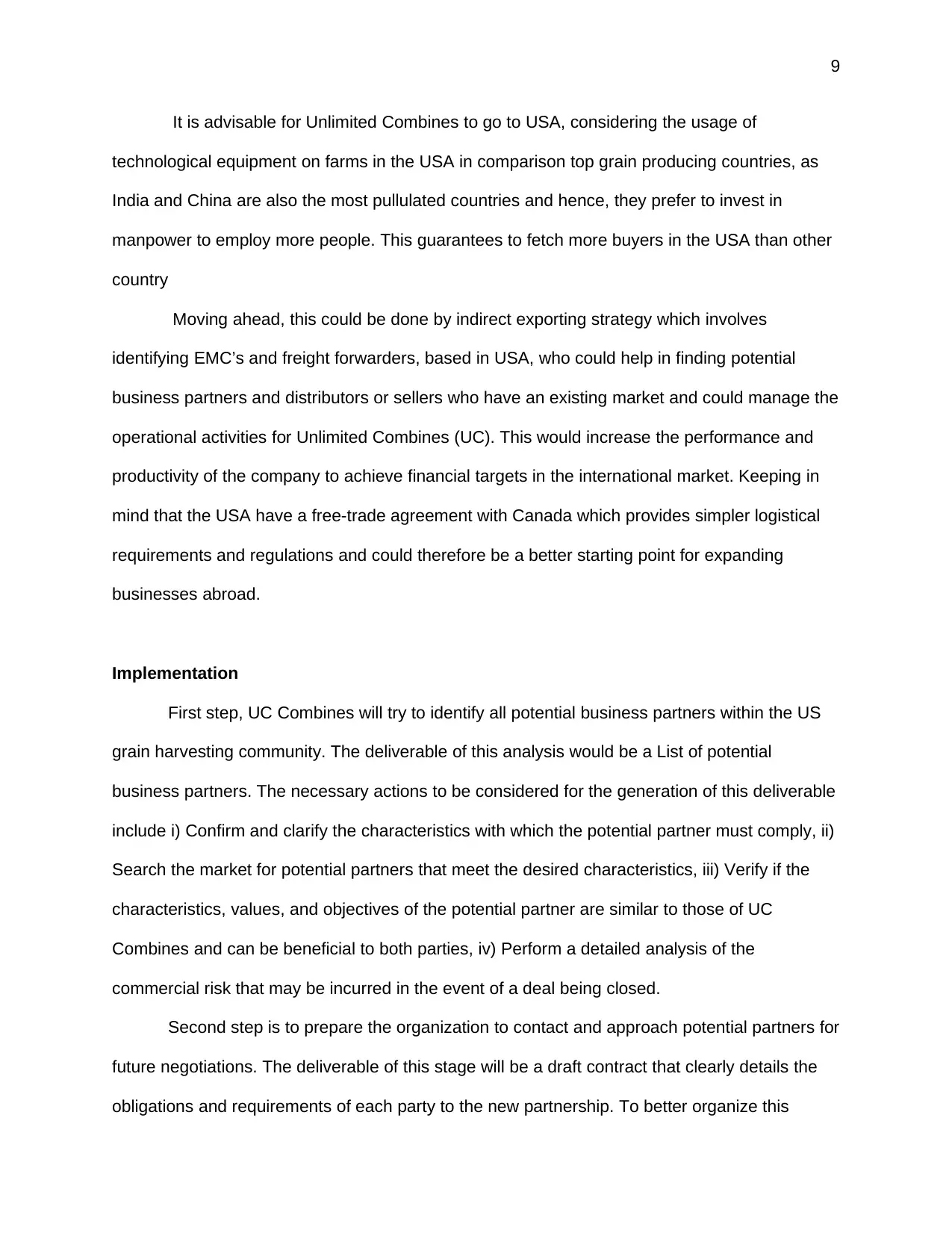
9
It is advisable for Unlimited Combines to go to USA, considering the usage of
technological equipment on farms in the USA in comparison top grain producing countries, as
India and China are also the most pullulated countries and hence, they prefer to invest in
manpower to employ more people. This guarantees to fetch more buyers in the USA than other
country
Moving ahead, this could be done by indirect exporting strategy which involves
identifying EMC’s and freight forwarders, based in USA, who could help in finding potential
business partners and distributors or sellers who have an existing market and could manage the
operational activities for Unlimited Combines (UC). This would increase the performance and
productivity of the company to achieve financial targets in the international market. Keeping in
mind that the USA have a free-trade agreement with Canada which provides simpler logistical
requirements and regulations and could therefore be a better starting point for expanding
businesses abroad.
Implementation
First step, UC Combines will try to identify all potential business partners within the US
grain harvesting community. The deliverable of this analysis would be a List of potential
business partners. The necessary actions to be considered for the generation of this deliverable
include i) Confirm and clarify the characteristics with which the potential partner must comply, ii)
Search the market for potential partners that meet the desired characteristics, iii) Verify if the
characteristics, values, and objectives of the potential partner are similar to those of UC
Combines and can be beneficial to both parties, iv) Perform a detailed analysis of the
commercial risk that may be incurred in the event of a deal being closed.
Second step is to prepare the organization to contact and approach potential partners for
future negotiations. The deliverable of this stage will be a draft contract that clearly details the
obligations and requirements of each party to the new partnership. To better organize this
It is advisable for Unlimited Combines to go to USA, considering the usage of
technological equipment on farms in the USA in comparison top grain producing countries, as
India and China are also the most pullulated countries and hence, they prefer to invest in
manpower to employ more people. This guarantees to fetch more buyers in the USA than other
country
Moving ahead, this could be done by indirect exporting strategy which involves
identifying EMC’s and freight forwarders, based in USA, who could help in finding potential
business partners and distributors or sellers who have an existing market and could manage the
operational activities for Unlimited Combines (UC). This would increase the performance and
productivity of the company to achieve financial targets in the international market. Keeping in
mind that the USA have a free-trade agreement with Canada which provides simpler logistical
requirements and regulations and could therefore be a better starting point for expanding
businesses abroad.
Implementation
First step, UC Combines will try to identify all potential business partners within the US
grain harvesting community. The deliverable of this analysis would be a List of potential
business partners. The necessary actions to be considered for the generation of this deliverable
include i) Confirm and clarify the characteristics with which the potential partner must comply, ii)
Search the market for potential partners that meet the desired characteristics, iii) Verify if the
characteristics, values, and objectives of the potential partner are similar to those of UC
Combines and can be beneficial to both parties, iv) Perform a detailed analysis of the
commercial risk that may be incurred in the event of a deal being closed.
Second step is to prepare the organization to contact and approach potential partners for
future negotiations. The deliverable of this stage will be a draft contract that clearly details the
obligations and requirements of each party to the new partnership. To better organize this
Paraphrase This Document
Need a fresh take? Get an instant paraphrase of this document with our AI Paraphraser
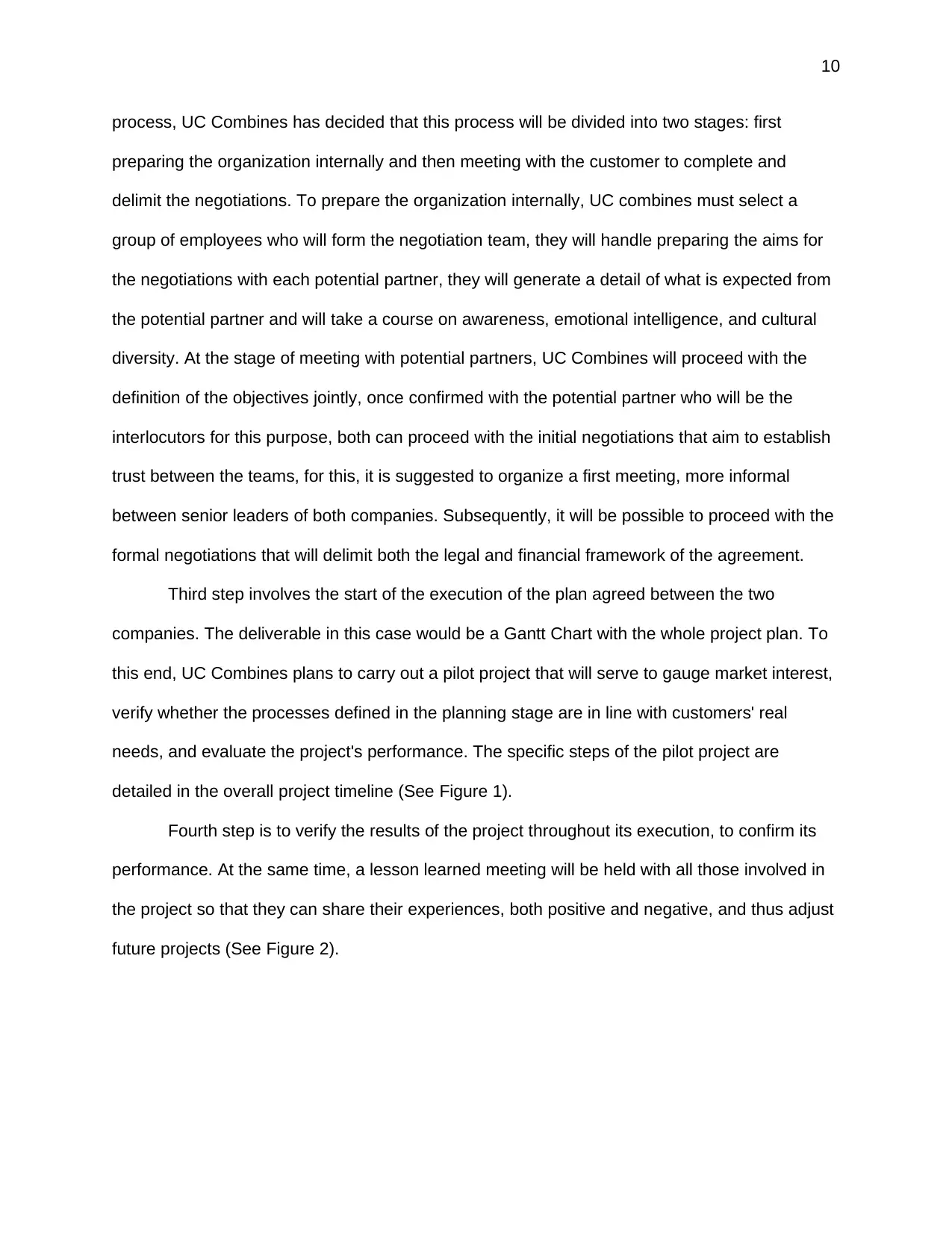
10
process, UC Combines has decided that this process will be divided into two stages: first
preparing the organization internally and then meeting with the customer to complete and
delimit the negotiations. To prepare the organization internally, UC combines must select a
group of employees who will form the negotiation team, they will handle preparing the aims for
the negotiations with each potential partner, they will generate a detail of what is expected from
the potential partner and will take a course on awareness, emotional intelligence, and cultural
diversity. At the stage of meeting with potential partners, UC Combines will proceed with the
definition of the objectives jointly, once confirmed with the potential partner who will be the
interlocutors for this purpose, both can proceed with the initial negotiations that aim to establish
trust between the teams, for this, it is suggested to organize a first meeting, more informal
between senior leaders of both companies. Subsequently, it will be possible to proceed with the
formal negotiations that will delimit both the legal and financial framework of the agreement.
Third step involves the start of the execution of the plan agreed between the two
companies. The deliverable in this case would be a Gantt Chart with the whole project plan. To
this end, UC Combines plans to carry out a pilot project that will serve to gauge market interest,
verify whether the processes defined in the planning stage are in line with customers' real
needs, and evaluate the project's performance. The specific steps of the pilot project are
detailed in the overall project timeline (See Figure 1).
Fourth step is to verify the results of the project throughout its execution, to confirm its
performance. At the same time, a lesson learned meeting will be held with all those involved in
the project so that they can share their experiences, both positive and negative, and thus adjust
future projects (See Figure 2).
process, UC Combines has decided that this process will be divided into two stages: first
preparing the organization internally and then meeting with the customer to complete and
delimit the negotiations. To prepare the organization internally, UC combines must select a
group of employees who will form the negotiation team, they will handle preparing the aims for
the negotiations with each potential partner, they will generate a detail of what is expected from
the potential partner and will take a course on awareness, emotional intelligence, and cultural
diversity. At the stage of meeting with potential partners, UC Combines will proceed with the
definition of the objectives jointly, once confirmed with the potential partner who will be the
interlocutors for this purpose, both can proceed with the initial negotiations that aim to establish
trust between the teams, for this, it is suggested to organize a first meeting, more informal
between senior leaders of both companies. Subsequently, it will be possible to proceed with the
formal negotiations that will delimit both the legal and financial framework of the agreement.
Third step involves the start of the execution of the plan agreed between the two
companies. The deliverable in this case would be a Gantt Chart with the whole project plan. To
this end, UC Combines plans to carry out a pilot project that will serve to gauge market interest,
verify whether the processes defined in the planning stage are in line with customers' real
needs, and evaluate the project's performance. The specific steps of the pilot project are
detailed in the overall project timeline (See Figure 1).
Fourth step is to verify the results of the project throughout its execution, to confirm its
performance. At the same time, a lesson learned meeting will be held with all those involved in
the project so that they can share their experiences, both positive and negative, and thus adjust
future projects (See Figure 2).
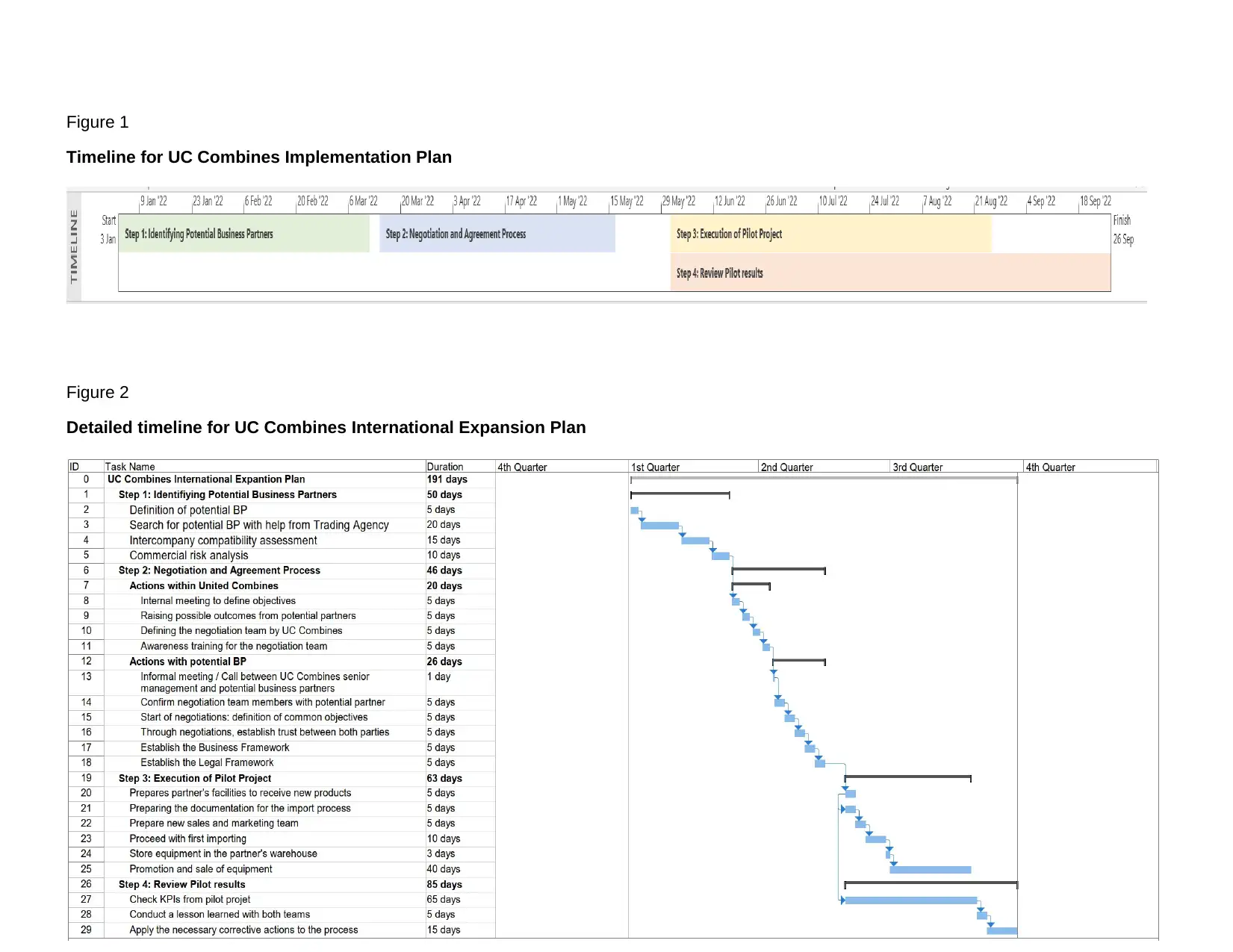
Figure 1
Timeline for UC Combines Implementation Plan
Figure 2
Detailed timeline for UC Combines International Expansion Plan
Timeline for UC Combines Implementation Plan
Figure 2
Detailed timeline for UC Combines International Expansion Plan
⊘ This is a preview!⊘
Do you want full access?
Subscribe today to unlock all pages.

Trusted by 1+ million students worldwide
1 out of 16
Related Documents
Your All-in-One AI-Powered Toolkit for Academic Success.
+13062052269
info@desklib.com
Available 24*7 on WhatsApp / Email
![[object Object]](/_next/static/media/star-bottom.7253800d.svg)
Unlock your academic potential
Copyright © 2020–2025 A2Z Services. All Rights Reserved. Developed and managed by ZUCOL.





